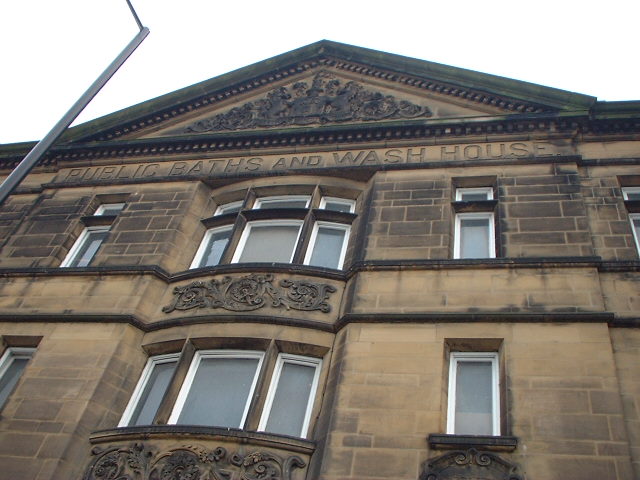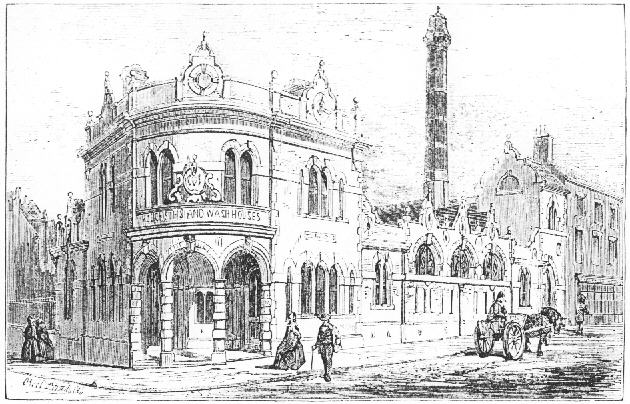Tyneside Family History.
[Main Menu.] [Tyneside History.] [Tyneside & Family Photographs.] [ Kane Family History.]
Baths and Wash House, Gibson Street.


A report written in 1845 which looked at the conditions of the people in Newcastle the problem of bathing was examined, along the Tyne it had been possible for the poorer classes to bath in the river but the development of the Quayside meant it was harder for the public to bath the only places left to bath were not secluded enough and were open to the view of well frequented pathways. The Ouseburn at about a mile outside town was mentioned as a bathing place but was mostly used in the summer. Baths open to the public on payment of a moderate fee have been recently erected and no expense spared to render them worth of the support of the public. There are situated in the upper part of town and are not conveniently placed for the use of the poorer classes. It was recommended that baths should be built that were accessible to the poorer public either free or for a very low charge and that it should be in the vicinity of a steam engine so that tepid baths could be provided in the winter. It was thought that once people got into the habit of bathing it would fill their leisure time and keep them off the streets and out of the public houses.
In Wards Trade Directory for 1907-08 I found several Corporation Bath and Washhouses,
Church street, T. Angus Manager.
Scotswood Road (Elswick), A. McWilliams. Manager.
Gallowgate, G. Innes. Manager.
Gibson Street, G. Innes, Manager.
Shipley Street, D. Munn Manager.
Northumberland Baths, Northumberland Road, J.W. Priestly. Manager.
Turkish and Russian Baths 55 Pilgrim Street, E Priestly prop.
In Wards Directory for 1906 I only found, Baths on City Road T.R. Barber, Manager.
A History and directory of Newcastle Upon Tyne, 1887.
Gallowgate, Edwd. Robson, manager.
City Road, P. Hastie, lessee.
Scotswood Road, R. Clark, supt.
Church Street, R. Clark supt.
Shipley street, D. Munn, manager.
------------
The above baths will shortly be open to the public.
Comfortable baths..6d; 30 transferable tickets 10s. 6d.
First Class Baths..1s; 30 transferable tickets 20s. 0d.
3 first class transferable tickets 2s. 6d.
6 second class transferable tickets 2s. 6d.
Baths and Washhouse Gallowgate.

The designer of the building has tried to make it stand out so as not to be mistaken for an asylum, mechanics institute or vestry hall. The superintendent's office is at the centre of the building and has a kitchen, small scullery, pantry, parlour and two bedrooms.
The baths are on the left hand side on entering the porch. There are fourteen warm and cold baths, with waiting rooms and conveniences attached. The baths are divided into first and second class. There is no plasterwork inside the washhouse or the bathrooms the whole of the walls are lined with glazed porcelain bricks of a warm buff colour.
The divisions between the baths in the first class are enamelled slate, of a pale green tinge, which contrasts with the buff brick walling and pale grey roof painting. The second-class bath partitions are plain slate smooth on both sides. The whole of the baths are formed in one-piece Stourbridge fireclay, coated on the outside with a layer of white porcelain.
The bath apartments are well ventilated. The washhouse is reached from the opposite side of the porch to the baths. In the passage way there is a spring door, which can be opened by the superintendent only from the office, for the purpose of preventing ingress and egress without being recorded. The washhouse is a spacious apartment, with glazed brick walls, painted iron roof, rows of skylights iron columns ornamental ventilating grates and other accessories.
Gibson Street runs down to City road were my grandfather James Kane was born in 1900, and my father was actualy born at 57 Gibson Street so it is possible that they may have used either the City road baths or the Gibson street baths.
Newcastle Council Reports, 1854-55
London Illustrated News, 13 August, 1859.
Report on Newcastle Upon Tyne and other towns. Parliamentry Papers 1845.
Wards Trade Directory for 1907-08.
Wards Trade Directory, 1854.
Water Fountains.
For the convenience of the poorer classes, the corporation had provided a number of public fountains or standpipes of which there were about 18 or 20 in different parts of the town. One in Gallowgate, Percy street, Darwer-crook, High Friar street, Newgate Street, Big Market, High Bridge, Head of the Side, Wesgate Street (called the Vicars pumop), foot of Pilgrim Street, Manor street, Sandgate West and East, St. Ann's row, East BallastHills, St. Lawrence, New Green Market (for the use of the markets) Leazes near the Cresent, and one was being prepared in the Close.
The cost of water laid on by the Joint Stock Water Company was 18s. to 30s. for private houses. Manufactures pay 3d. to 4d. for every 224 gallons. The poor pay one farthing for a tub or large pail full, which is four or five times more than the richer inhabitants of the town who can afford to have the water conveyed to their houses. The cost of water for the poorer classes is due to the fact that the water company has to pay for an attendant to at each standpipe where the poor are supplied.
Wards Trade Directory for 1907-08.
A History and directory of Newcastle Upon Tyne, 1887.
Wards Trade Directory, 1854.